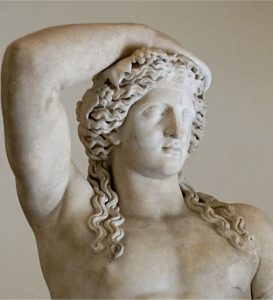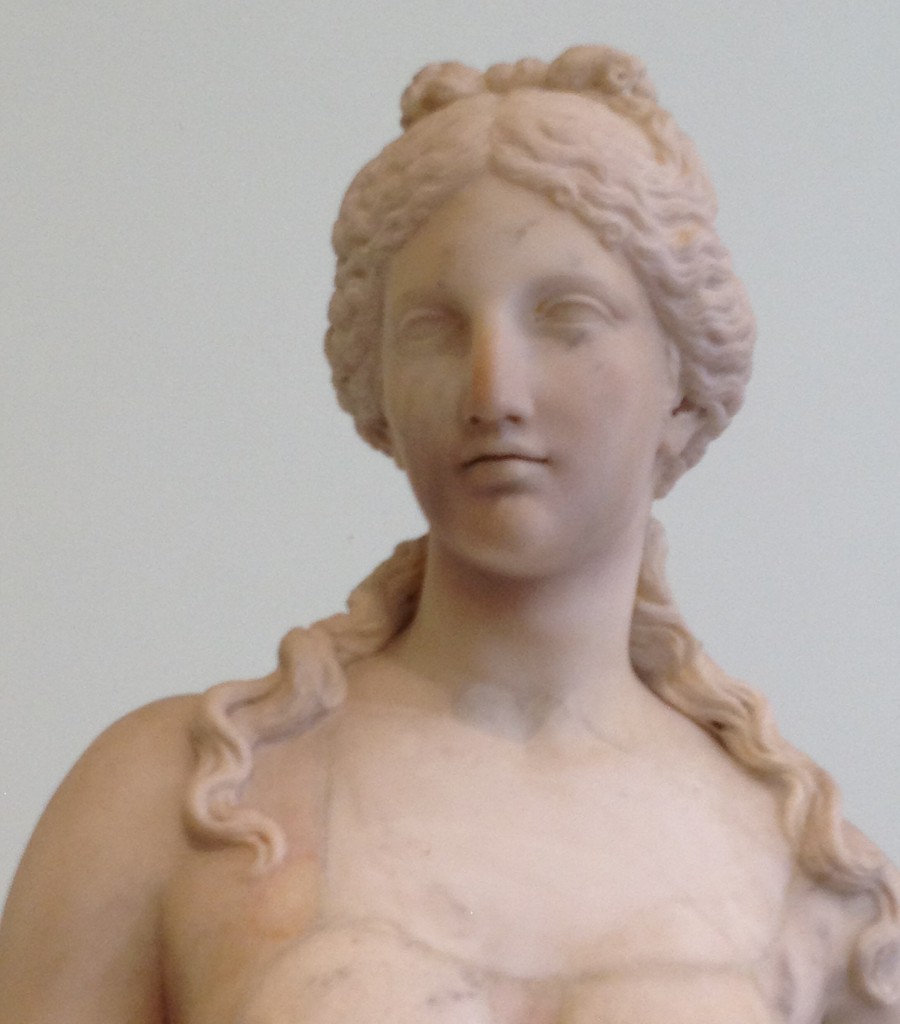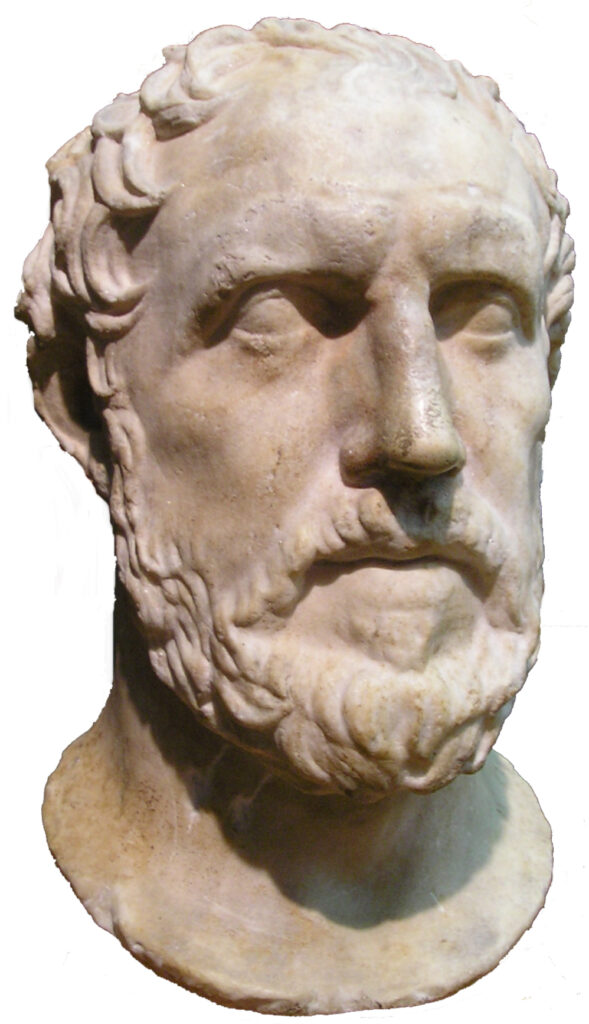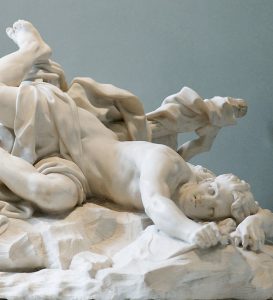Below are downloadable source texts in PDF format, along with links to html versions to read online here at this website. They include texts that have been revised by members of Kosmos Society. These texts have been augmented with key vocabulary terms.
We have also provided some links to related material.
This list will develop over time, so please check back periodically. Enjoy!
You can click on the links in the following list to jump to the relevant part of the page, or you can scroll down:
Homeric and Epic Poetry | Other Poetry | Histories | Tragedy | Philosophy and other texts | Sourcebook | Center for Hellenic Studies
At the end of the page you can find a link to further reading available from the Center for Hellenic Studies Online Publications.
Homer, Hesiod, Epic Cycle, Homeric Hymns
Overview
- Gregory Nagy 2013. “Introduction to Homeric poetry” (from The Ancient Greek Hero in 24 Hours)
- Gregory Nagy 2009. “Epic” (from The Oxford Handbook of Philosophy and Literature, ed. Richard Eldridge, Oxford.)
- Online Open House videos on Epic themes, Homeric Epic, Epic Cycle and Homeric Hymns
- A Homeric Commentary in Progress
Homeric Iliad
 Homer, Iliad [html | PDF]
Homer, Iliad [html | PDF]
Samuel Butler’s translation, revised by Timothy Power, Gregory Nagy, Soo-Young Kim, and Kelly McCray.
Published under a Creative Commons License 3.0.
Translation augmented with H24H Core Vocab terms.
Included in Sourcebook
The wrath [mēnis] of Achilles dominates the action of the Homeric Iliad, set during the Trojan War, which has been going on for more than nine years. Paris (Alexandros), the son of Priam, has taken Menelaos’ wife Helen. The Achaean forces are assembled along the beach near Ilion, comprising forces from all across Greece, under the leadership of Agamemnon, to reclaim Helen.
This first of the greatest epics of ancient Greece opens with a quarrel between Achilles, best of the Achaeans, and Agamemnon. As a result, Achilles withdraws from the fighting, leaving the others to battle the Trojans and their allies. The gods, divided in their support for the warring sides, watch and sometimes intervene in the action. There are great battle sequences, vivid micro-narratives, and sweeping drama, with the anger, and the grief, of Achilles culminating in powerful and emotional scenes.
Image: Sir Richard Westmacott: Statue of Achilles, Hyde Park, London. Photo: Kosmos Society
Homeric Odyssey
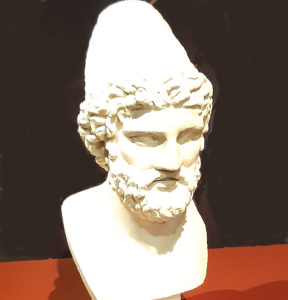 Homer, Odyssey [html | PDF]
Homer, Odyssey [html | PDF]
Samuel Butler’s translation, revised by Timothy Power, Gregory Nagy, Soo-Young Kim, and Kelly McCray.
Published under a Creative Commons License 3.0.
Translation augmented with H24H Core Vocab terms.
Included in Sourcebook
Odysseus, versatile in his thinking, full of wiles, wandering far and wide on his attempt to find his way back from the Trojan War, constantly reinventing himself, encountering men, monsters, storms, deities, supernatural beings, and even the dead in Hādēs, while he is always longing to return to his wife Penelope.
This second great epic features the hero who, unlike Achilles, was actually there at the fall of Troy. However, his return voyage, which starts with Odysseus still full of his exploits, keeps taking unexpected turns, many as the result of his own choices. Meanwhile, back on Ithaka, Penelope and their son Telemachus have problems of their own, with the persistence of the suitors. The narrative takes as many twists and turns as Odysseus himself, until the final climax and the reunion of all the threads in this intricately woven tale.
Image: Head of Odysseus, Roman, late 1st to early 2nd century CE. Musée d’Art Classique de Mougins. Photo: Kosmos Society
Related
- Odyssey ‘Round the World playlist of videos—every Rhapsody recorded by students, faculty, and actors around the world. Kosmos Society members took part in Rhapsody 22.
Epic Cycle
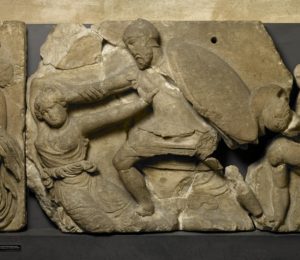 The Epic Cycle [html | PDF]
The Epic Cycle [html | PDF]
Translated by Gregory Nagy, Revised by Eugenia Lao.
Published under a Creative Commons License 3.0.
Translation augmented with H24H Core Vocab terms.
Included in Sourcebook
The Epic Cycle comprised a number of epic poems covering the events leading up to the Trojan War, the war itself, and its aftermath. Only summaries or fragments remain of most of these, with the exception of the Iliad and Odyssey.
This translation is of Proclus’ summaries of: the Cypria, attributed to Stasinus of Cyprus (the Judgment of Paris, Paris and Helen’s departure for Troy, and the start of the Trojan War); the Aithiopis, attributed to Arctinus of Miletus (the Amazons, Memnon, and the death of Achilles); the Little Iliad, attributed to Lesches of Lesbos (the judgment for the armor of Achilles, the retrieval of Philoctetes and Neoptolemos, and the deployment of the Wooden Horse); the Iliou Persis, attributed to Arctinus of Miletus (the destruction of Ilion); and the Nostoi, attributed to Agias of Trozen (the Homecomings).
Image: carved marble slab from frieze of the temple of Apollo at Bassae. Creative Commons Attribution-NonCommercial-ShareAlike 4.0 International (CC BY-NC-SA 4.0) license © The Trustees of the British Museum
Hesiodic Theogony
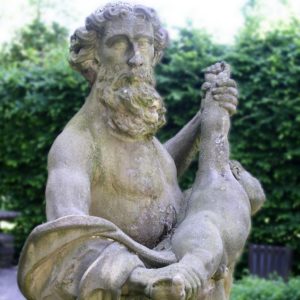 Hesiod, Theogony [html | PDF]
Hesiod, Theogony [html | PDF]
1–115 Translated by Gregory Nagy, 116–1022 Translated by J. Banks and adapted by Gregory Nagy.
Published under a Creative Commons License 3.0.
Translation augmented with H24H Core Vocab terms.
Included in Sourcebook
This poem, narrated in the persona of Hesiod, opens with the poet receiving knowledge directly from the Muses. The invocation to the Muses concludes: “Tell how the gods and the earth were generated at the very beginning, and the rivers and the boundless pontos, seething with waves, and the shining stars and the vast sky above. Tell of the gods, givers of good things, who were generated from them, and how they divided up their wealth and how each one chose his or her tīmē. And how in the very beginning they came to possess Olympus with its many ridges. Tell me these things, Olympian Muses, you who abide in Olympus, tell it from the beginning, about what was generated first from among them all.” There follows a cosmology, and accounts of the creation and conflicts of the gods and their descendants, titans, and mortals.
Image: Detail from Kronos, statue in Hesperidengarten.
Photo: )o(Medousa)o( CC-BY-SA 3.0, Wikimedia Commons
Hesiodic Works and Days
 Hesiod, Works and Days [html | PDF]
Hesiod, Works and Days [html | PDF]
Translated by Gregory Nagy.
Published under a Creative Commons License 3.0.
Translation augmented with H24H Core Vocab terms.
Included in Sourcebook
In this poem, the persona of Hesiod addresses his brother Perses, providing guidance on justice and good practice for individuals and for the community. Incorporating myths to illustrate the themes, including the Five Ages of Man, the work is an example of didactic poetry. It extols hard work, in particular how to plan activities in harmony with the natural cycles of nature.
Image: Marble head of an old man, perhaps the poet Hesiod. Roman copy after a lost Hellenistic original of 2nd century BCE. British Museum.
Photo: Kosmos Society
Homeric Hymns
Homeric Hymn to Demeter
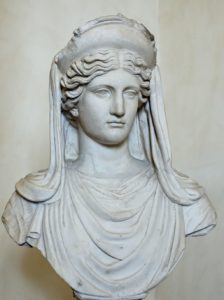 Homeric Hymn to Demeter [html | PDF]
Homeric Hymn to Demeter [html | PDF]
Translated by Gregory Nagy.
Published under a Creative Commons License 3.0.
Translation augmented with H24H Core Vocab terms.
Included in Sourcebook
Homeric Hymn (2) to Demeter tells the story of Persephone’s abduction by Hādēs, god of the underworld, and of her mother Demeter’s reaction in her great grief. It incorporates another narrative, about how Demeter, in the guise of an old woman, takes on the care of Metaneira’s baby son, although her efforts to secure immortalization for the boy are misunderstood by the household. Despite revealing her true identity and receiving honors there, Demeter still grieves for her daughter and prevents the grain from growing. Finally, to prevent famine, Zeus arranges for Persephone to return and the fertility of the land to be restored. This myth is one version of how the cult of Demeter and her Mysteries began, associated with Eleusis. Gregory Nagy’s notes to this translation throw light on the sometimes obscure references to the Eleusinian Mysteries.
Image: Demeter. Marble, Roman copy after a Greek original from the 4th century BCE. Museo nazionale romano di palazzo Altemps. Photo: Jastrow, public domain, via Wikimedia Commons
Homeric Hymn to Dionysus
Homeric Hymn to Dionysus [html | PDF]
Translated by Gregory Nagy.
Published under a Creative Commons License 3.0
Translation augmented with H24H Core Vocab terms.
Included in Sourcebook
The Homeric Hymn (7) to Dionysus is the longest of the three hymns to this god. Within the framework of the hymn, it tells the story of a group of sailors who encounter the god Dionysus in the guise of a beautiful young man. Since the men are pirates, they capture him—but the power of the god to overcome his bonds is too much for them.
It is only the steersman who recognizes the true nature of their supposed captive. And when the god manifests marvelous signs, most of the crew are terrified and as they try to escape undergo a transformation. However, the steersman experiences salvation when Dionysus acknowledges him in turn.
Image: Detail from Marie-Lan Nguyen (photo) Dionysos and satyr, marble, Roman copy from 2nd century CE after a Hellenistic original, partially restored, National Museum of Rome, public domain, via Wikimedia Commons
Homeric Hymn to Aphrodite
Homeric Hymn to Aphrodite [html | PDF]
Translated by Gregory Nagy.
Published under a Creative Commons License 3.0.
Translation augmented with H24H Core Vocab terms.
Included in Sourcebook
The greater of the two Homeric Hymns celebrating Aphrodite is a beautiful hymn for its subject matter and style, and an important poetic text in the history of Greek religion and world literature. It begins as a hymn celebrating the aretai and tīmai ‘honors’ of the goddess Aphrodite, distinguishing her jurisdiction and influence from three other goddesses into whom she does not strike erotic desire and passion—Athena, Hera, and Hestia—and celebrating her beauty, virtues, and legends in a narrative tantamount to small epic (epyllion). The focus of the narrative is the story of Aphrodite’s herself being struck with passion, instigated by Zeus, for a Trojan hero Anchises, son of Dardanos, appearing in human disguise to Anchises as he was herding cattle on the lonely slopes of Mount Ida, becoming the mother of Aineias (or as the Romans would spell the name, Aeneas), and parting with instructions to Anchises not to tell anyone of the affair. Wrapped in the narrative are a wealth of exquisitely composed epic scene painting (particularly outstanding the description of the wild animals whose breasts Aphrodite fills with desire) and the Aphrodite’s Ganymede and Tithonos (exemplum) micronarratives.
The poem is a great read and study in itself, and as part of the greater Homeric hymn song culture. Students of Virgil who have read and understood this hymn understand Aeneas’ birth and upbringing, as well as other important aspects of Aeneas’ background that will enrich understanding of the Aeneid. Visiting scholar Leonard Muellner’s video posted on the Kosmos Society website explains the significance of Aphrodite’s evidently unheeded warning to avoid the mēnis ‘cosmic anger’ of Zeus, as well as other deep aspects of the narrative and connections with relevant Greek thought about their gods and relationships between gods and mortals. Coming after Professor Muellner’s and Professor Nagy’s discussions of mēnis in HeroesX, this hymn and Professor Muellner’s video build on the content of HeroesX, but for students and scholars who have not participated in HeroesX, they may serve as a good introduction to Professor Muellner’s cosmic mēnis hermeneutics and provide content that may be helpful to readers of the Iliad. The Homeric Hymns, including the Hymn to Aphrodite, are an important body of poetic work surviving from early Greek epic song culture, much admired by the Hellenistic scholar-poet Callimachus, who pays homage to them by imitating them, and by the great Latin poet Lucretius, whose great ode to alma Venus owes much to the Homeric Hymn to Aphrodite.
(overview by Jack Vaughan)
Related
Other Poetry
Overview
- Online Open House videos on Other Greek poetry
Pindar
 Pindar, Pythian 8 [html | PDF]
Pindar, Pythian 8 [html | PDF]
Translation and notes by Gregory Nagy.
Published under a Creative Commons License 3.0.
Translation augmented with H24H Core Vocab terms.
Included in Sourcebook
Pindar was a lyric poet who flourished in the first half of the fifth century BCE. The victory ode, or epinician, is the only lyric genre to survive from Pindar’s vast lyric repertoire as a near-complete corpus. Pythian 8 , composed by Pindar to be sung and danced by an ad hoc local khoros in the island-state of Aigina, was commissioned by the family of an aristocrat named Aristomenes, as a celebration of his victory in the wrestling event at the Pythian Games of 446 BCE. Also included are short passages relevant to the poetics of Pindar.
(overview of Pythian 8 based on introductory notes by Gregory Nagy in the translation and in Pindar’s Homer)
Pindar Pythian 2, Introduction, translation and notes by Jack Vaughan
Pindar Nemean 1, translation and notes by Jack Vaughan
Pindar Nemean 2, translation and notes by Jack Vaughan
Image: Athletic victor, Attic votive relief, c 460 BCE athletic victor from National Archaeological Museum Athens.
Photo: Kosmos Society
Related
- Gregory Nagy. 2000. “Dream of a Shade”: Refractions of Epic Vision in Pindar’s Pythian 8 and Aeschylus’ Seven against Thebes
- Gregory Nagy. 1990. Pindar’s Homer: The Lyric Possession of an Epic Past
Sappho
 Poetry of Sappho, [html | PDF]
Poetry of Sappho, [html | PDF]
Translated by Gregory Nagy, further selections translated by Julia Dubnoff
Published under a Creative Commons License 3.0.
Gregory Nagy’s translations augmented with H24H Core Vocab terms.
Included in Sourcebook
Sappho was a lyric poet who composed in the late seventh and early sixth century BCE. Her poetry was much admired in antiquity, but only a few poems and fragments remain of her prolific output. Little is known of her life, but her poems capture personal emotions, ritual contexts, longing, and beautiful imagery. The poems include a “Prayer to Aphrodite,” the “Wedding of Hector and Andromache,” the “Brothers Song,” and selected fragments. Also included are passages from other sources that are relevant to the poetics of Sappho, including epigrams and related sources, with summaries and commentary by Gregory Nagy.
Image: Head of the poetess Sappho, Marble copy of Hellenistic prototype. Photo: P Vasiliadis, Creative Commons Attribution-Share Alike 3.0 Unported license via Wikimedia Commons.
Related
Alcman
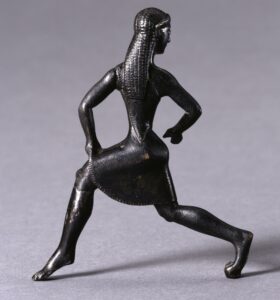 Alcman, Partheneion [html | PDF]
Alcman, Partheneion [html | PDF]
Translated by Gregory Nagy. Published under a Creative Commons License 3.0.
Translation augmented with H24H Core Vocab terms.
Included in Sourcebook
“The Partheneion, the ‘Maiden Song’, was reputedly composed by a legendary poet named Alcman for performance at a seasonally recurring grand public festival in Sparta.
The words in this passage indicate a ritual of female initiation in the public space of Sparta, where the entire male and female population is experiencing contact with the divine. The climactic moment in this ritual is marked by an epiphany, as marked here by the words that I translate ‘shine with sunlight’.”
(Gregory Nagy, The Ancient Greek Hero in 24 Hours 5§60–61.)
Image credit: Bronze figure of a running girl, Creative Commons Attribution-NonCommercial-ShareAlike 4.0 International (CC BY-NC-SA 4.0) license
© The Trustees of the British Museum
Theognis
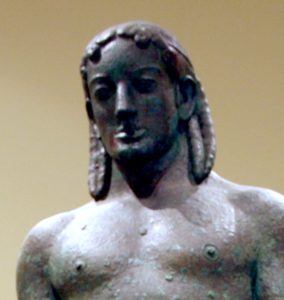 Theognis of Megara [html | PDF]
Theognis of Megara [html | PDF]
Translated by Gregory Nagy.
Published under a Creative Commons License 3.0.
translations augmented with H24H Core Vocab terms.
Included in Sourcebook
We find exponents of justice who become cult heroes by way of their poetry. … And there are exponents of justice who are worshipped as cult heroes in individual city-states. Some of these heroes are viewed as lawgivers or quasi-lawgivers. When a hero is viewed by a city-state as its lawgiver, he can also be viewed as the author of that given city’s customary laws. In myths about lawgivers, such authorship is traditionally correlated with some kind of fundamental crisis that afflicts the given city. Theognis of Megara is one such example. There is no fixed date for Theognis: he is credited with the creation of poems that can be dated as far apart as the late seventh and the early fifth centuries BCE. Although the poetry attributed to Theognis can be traced back primarily to one specific social context, which was the metropolis or ‘mother city’ of Megara and its daughter cities, most of this poetry is composed in such a generalized way that it can apply to a wide variety of other social contexts in other cities.
(overview based on extracts from Gregory Nagy, The Ancient Greek Hero in 24 Hours)
Image: detail from Piraeus Apollo, bronze, 530–500 BCE. Archaeological Museum of Piraeus. Photo: Giovanni Dall’Orto, attribution via Wikimedia Commons.
Related
- Gregory Nagy Theognis and Megara: A Poet’s Vision of his City
- Thomas J Figueira Theognidea and Megarian Society
Other poets
“Shuttles that sang at dawn”: a dedicatory epigram from The Greek Anthology translated by Jack Vaughan
Ariadne: Abandonment and Translation | Nonnos Dionysiaka 47. 265–313, translation and notes by Jack Vaughan
History
Overview
Herodotus: Histories
Herodotus, Selections Part I (from Scroll 1) [html | PDF]
First phase of translation by Lynn Sawlivich. Second phase of translation by Gregory Nagy, Keith DeStone, Claudia Filos, and Sarah Scott.
Published under a Creative Commons License 3.0.
Translation augmented with H24H Core Vocab terms.
Included in Sourcebook
Herodotus, Selections Part II (from Scrolls 1–9) [html | PDF]
First phase of translation by Lynn Sawlivich. Second phase of translation by Gregory Nagy, Keith DeStone, Claudia Filos, and Sarah Scott.
Published under a Creative Commons License 3.0.
Translation augmented with H24H Core Vocab terms.
Included in Sourcebook
Known as the “father of history,” Herodotus (c 484–424 BCE) introduces his work as follows: “This is the making public [apodexis] of the inquiry [historiā] of Herodotus of Halicarnassus, so that what arises from human essence not become faded [exitēla] by time, and that great and wondrous deeds, some performed [apodekh-] by the Hellenes, some by the barbarians, not lose their kleos, including for what cause [aitiā] they waged war against each other.”
His Histories were based on accounts he collected during his extensive travels, and provide evidence of local traditions, myths, and rituals using very precise language.
The first selection of passages is taken from Scroll 1, and focuses on the Lydian ruler Croesus, including his encounters with the Athenian lawgiver Solon, and with the Persian ruler Cyrus. Herodotus also tells about the use of oracles, the discovery of Orestes’ bones, and the customs of people in different countries.
The second selection of passages is taken from Scrolls 1–9, and includes accounts of mythical and historical figures and various military and naval engagements. The subjects of the selections are: Kyrnos, Tīmēsios, Hēraklēs, Hesiod and Homer, Philippos, Onesilaos, Marathon, Miltiades, Helen, Astrabakos, Artakhaiēs, Talthybios, Thetis, Plataea, and Protesilaos.
Image: Marble bust of Herodotos, Roman, 2nd century CE, copy of Greek original bronze of 4th century BCE. Public domain, The Metropolitan Museum of Art.
Thucydides
Thucydides, Book 1 chapters 1-23 [html | PDF]
Adapted 2023 by the Kosmos Society team in consultation with Jeffrey Rusten, from the translation by Richard Crawley (first published in 1874 and revised 1910 by Richard Feetham.
Translation augmented with Key terms for Thucydides Book 1.
The selection, chapters 1-23, includes Thucydides’ opening statement, the ‘Archaeology’, and a Preface in which he outlines his methods.
Image credit: Bust of Thucydides from the Royal Ontario Museum, Public domain, via Wikimedia Commons
Related
- Overview of Thucydides’ Peloponnesian War Book 1—video in which Jeffrey Rusten introduces the structure and themes of Book 1
- Introducing an augmented translation of Thucydides: Book 1—includes introductory videos with Jeffrey Rusten
 Thucydides, Selections from Book 2 [html | PDF]
Thucydides, Selections from Book 2 [html | PDF]
Adapted 2022 by the Kosmos Society Team (Keith DeStone, Hélène Emeriaud, Janet M. Ozsolak, Sarah Scott) in consultation with Jeffrey Rusten, from the translation by Richard Crawley (first published in 1874 and revised in 1910 by Richard Feetham)
Published under a Creative Commons License 3.0.
Translation augmented with Key Words for Thucydides.
The selected part of Book 2—chapters 34–65—includes some important and famous sections, and within these are particular focus passages indicated by highlighting. These sections are Pericles’ Funeral Oration, the plague in Athens, Pericles’ last speech, and Thucydides’ assessment of Pericles.
Image credit: Bust of Pericles bearing a Greek inscription “Pericles, son of Xanthippus, Athenian”. Marble, Roman copy after a Greek original from c 430 BCE. Museo Pio-Clementino, Muses Hall.
Photo: Jastrow (2006). Public domain, via Wikimedia Commons
Related
- Introducing an augmented translation of Thucydides: Book 2—includes introductory videos with Jeffrey Rusten
Pausanias
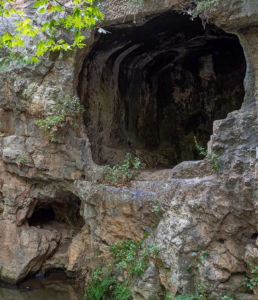 Selections from Pausanias [html | PDF ]
Selections from Pausanias [html | PDF ]
Translated by Gregory Nagy
Published under a Creative Commons License 3.0.
Translation augmented with H24H Core Vocab terms.
Included in Sourcebook
Pausanias was a historian writing in the middle of the 2nd century CE with detailed descriptions of Greek sites, antiquities, myths, and customs that he observed in different locations around mainland Greece.
These selections include Pausanias’ detailed description of the rituals associated with consulting the oracle of Trophonios from Book 9, as well as passages from Book 2 concerning sacred spaces and the myth of Hippolytus, from Book 6 about the goddess Eileithuia, and from Book 8 about a site connected with Odysseus.
The whole of the Description of Greece based on the translation of W.H.S. Jones and retranslated by Gregory Nagy is available online.
Image credit: Trophonios oracle, springs of river Herkyna
Photo C messier, Creative Commons Attribution-Share Alike 4.0 International license, via Wikimedia Commons
Tragedy
Overview
- “Introduction to tragedy” in Gregory Nagy 2013. The Ancient Greek Hero in 24 Hours
- “The Structure of Greek Tragedy: An Overview” by Jack Vaughan
- Reading Greek Tragedy Online: video reading and discussion of ancient Greek tragedy, with Out of Chaos Theatre, hosted by Joel Christensen and featuring special guests
- Videos: Online Open House discussions about tragedy (and comedy)
AESCHYLUS
Aeschylus Seven Against Thebes
 Seven Against Thebes, Aeschylus [html | PDF]
Seven Against Thebes, Aeschylus [html | PDF]
Translated by Herbert Weir Smyth, revised by members of Kosmos Society.
Published under a Creative Commons License 3.0.
Translation augmented with H24H Core Vocab terms.
Handout: Introduction to the play, by Jack Vaughan (PDF)
Introduction to Aeschylus Seven Against Thebes
From its first performance at the City Dionysia in 367 BCE, this drama has been widely recognized as an exceptional tragedy. A strong point of Aeschylus’ dramatic poetry, like Homer’s epics, is that allies and enemies are portrayed as lifelike or equally larger than life, evenhandedly critical, not patently reductive of a whole cast of characters on the other side. It delivers the scenes of battle at the seven gates by great narrative delivered by the scout “messenger” who focuses on key aspects of the scenes at the gates, not least the shields of the leaders of the attacking armies, and the scout’s candid reports of what he has seen and heard during stage time and his characterizations of the adversaries. The play continued to be popular in the post-classical period and in later Antiquity. One reason may have been that, like tragedies of Sophocles and Euripides included in corresponding Byzantine triads, it tells so much of the subject of the in Antiquity prized Theban epic Thebais. Today it is a great read (very moving in live reading in parts) both for the drama, including the characterizations of the heroes on both sides and the role-reversing character development of Eteokles and the Chorus of Theban maidens onstage, and for Aeschylus’ bold heroic poetry. (overview by Jack Vaughan)
Image: Ευπάτωρ Etruscan architectural plaque from the column of the temple A at Pyrgi. Scene from the Theban Cycle, the Seven against Thebes, c470–460 BCE, GFDL 1.2, from Wikimedia Commons
Related
- Reading Greek Tragedy Online: Aeschylus Seven Against Thebes video
Oresteia Trilogy
Aeschylus Agamemnon
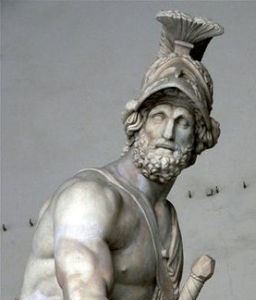 Agamemnon, Aeschylus [html | PDF]
Agamemnon, Aeschylus [html | PDF]
Translated by Herbert Weir Smyth. Revised by Gregory Crane and Graeme Bird. Further revised by Gregory Nagy.
Published under a Creative Commons License 3.0.
Translation augmented with H24H Core Vocab terms.
Included in Sourcebook
Agamemnon is the first of the Oresteia trilogy of tragedies, the best-known works of Aeschylus, first produced in 458 BCE as part of the Athenian City Dionysia. In Athenian society at this period, tragedies were performed as part of ritual dramatic festivals and formed part of the education of young citizens. The dramas focused on the sufferings of the hero and through their reactions the audience shared in these ordeals as they were reenacted.
As is typical of the plays of Aeschylus, Agamemnon centers on a hero who was familiar from the epic cycle. The drama focuses on his homecoming, in which he finally has to face the consequences of his actions.
Agamemnon had led a fleet of Achaeans to Troy, in a quest to reclaim Helen, the wife of his brother Menelaos, and the drama opens with the news that, after ten years, Troy has finally fallen, and that Agamemnon is returning in triumph. But with lament of the Chorus, it becomes clear what terrible price Agamemnon had paid to ensure the fleet sailed in the first place. Clytemnestra’s apparent welcome hides her dark intention for vengeance. Another victim is the seer Kassandra, whom Agamemnon has brought home from Troy as part of his spoils. The city of Argos is left in the hands of Clytemnestra’s lover, Agamemnon’s cousin Aegisthus, but with the prospect of a continuation of the cycle of killing and revenge that has already been part of the family history for two generations.
Image: detail from “Menelaus Supporting Patroclus 4,” by Mary Harrsch, CC BY-NC-SA 2.0
Related
- Reading Greek Tragedy Online: Aeschylus Agamemnon video
Aeschylus Libation Bearers
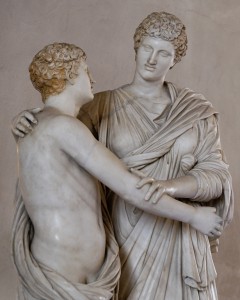 Libation Bearers, Aeschylus [html | PDF]
Libation Bearers, Aeschylus [html | PDF]
Translated by Jim Erdman. Further revised by Gregory Nagy.
Published under a Creative Commons License 3.0.
Translation augmented with H24H Core Vocab terms.
Included in Sourcebook
In the second play in the Oresteia trilogy, the action continues with Agamemnon’s daughter Electra seeking to conduct the appropriate libation rites to honor her father. When she encounters her brother, Orestes, who has returned from exile at the behest of Apollo’s oracle, their reunion at their father’s grave reinforces their desire to avenge his murder.
Having gained admittance to the palace, Orestes successfully kills Aegisthus, and, despite her attempts to win back his sympathy for her as his mother, he also kills Clytemnestra.
But now a new wave of vengeance seems likely to begin, with Orestes being haunted by a vision of the Erinyes, or Furies, hounding him in his turn, leaving him no option but to flee into exile once more.
Image: Orestes and Electra, Wikimedia Commons, Creative Commons Attribution 2.5 Generic license
Related
- Reading Greek Tragedy Online: Aeschylus Libation Bearers video
Aeschylus Eumenides
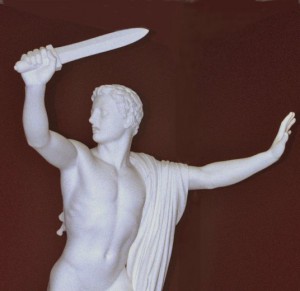 Eumenides, Aeschylus [html | PDF]
Eumenides, Aeschylus [html | PDF]
Translated by Herbert Weir Smyth. Revised by Cynthia Bannon. Further revised by Gregory Nagy.
Published under a Creative Commons License 3.0.
Translation augmented with H24H Core Vocab terms.
Included in Sourcebook
In the final instalment of the trilogy, Orestes has taken refuge at the temple of Apollo. Following the advice of the god, Orestes sets out to seek release at the temple of Athena in Athens. But the dreadful ghost of Clytemnestra still calls for vengeance and the Erinyes pursue him relentlessly, throwing curses in his wake.
In Athens, Orestes supplicates Athena, and the goddess hears his story. She sets in motion a tribunal, appointing judges from the citizens, and both Orestes and the Erinyes state their case, with Apollo speaking on Orestes’ behalf. Athena herself makes the final judgement, and establishes a new order in which the cycle of vengeance is replaced: she offers to the Erinyes a place where they can be worshipped and honored as the Eumenides and bring abundance to the land.
Image: Orestes Fleeing From the Furies, by Herman Wilhelm Bissen, public domain, Wikimedia Commons
Related
- Reading Greek Tragedy Online: Aeschylus Eumenides video
EURIPIDES
Euripides Helen
 Helen, Euripides [html | PDF]
Helen, Euripides [html | PDF]
Translated by E.P. Coleridge, revised by members of Kosmos Society (then Hour 25.)
Published under a Creative Commons License 3.0.
Translation augmented with H24H Core Vocab terms.
Helen of Troy—a misnomer according to Euripides. As Helen herself tells us in her monologue that opens Euripides’ Helen, Helen of Sparta never went to Troy with Paris, but a lookalike phantom [eidōlon | εἴδωλον] given by Hera to Paris made it seem so. The Trojan War was fought not over her, but over an illusion. When the fake likeness of Helen went to Troy; Hermes removed the real Helen to the palace and protection of the kings of Egypt, the deceased Proteus and now, since Proteus’ death, his son and successor Theoklymenos. Helen informs the audience that she has remained faithful to her Achaean husband Menelaos, although her reputation has been damaged to the point that she is hated throughout the Greek world. Now that Theoklymenos is on the throne, she no longer enjoys the protection of her chastity that Proteus had provided. Theoklymenos even wants to bed and wed her. The ensuing drama, like other Euripidean tragedies proceeds swiftly through a series of charged dramatic scenes with speech and song of the heroes and supporting characters, including a chorus of Greek women, that come together to deliver a two-part cliffhanger, of which both parts are stages of the protagonist Helen’s and her husband’s salvation, and both hinge on themes of purposeful disconnects and interplay between appearances and reality. The first grand illusion was a creation of the gods. The second is the eponymous hero’s (heroine’s) plan. Together they make complementary statements about deceptive appearances’ great destructive potential in some cases and elements of improbable rescue in others. Helen is a fine drama, a succession of scenes packed with irresistible suspense and dramatic irony punctuated by some of Euripides’ most beautiful choral odes. It features a strong protagonist, Helen, and a cast of heroic and other supporting characters, all parts brilliantly scripted for their characters and roles in the drama. Although, like Sophocles’ tragedy Philoktetes and other Ancient Greek, including Euripidean tragedies, the drama ends happily for the major characters, it is a serious tragedy that grapples with serious issues of the human condition—love, war, and the limits of human knowledge and understanding. (overview by Jack Vaughan)
Image: Antonio Canova: Helen of Troy. 1812. V&A, London. Photo: Kosmos Society.
Related
- Reading Greek Tragedy Online: Euripides Helen video
Euripides Herakles
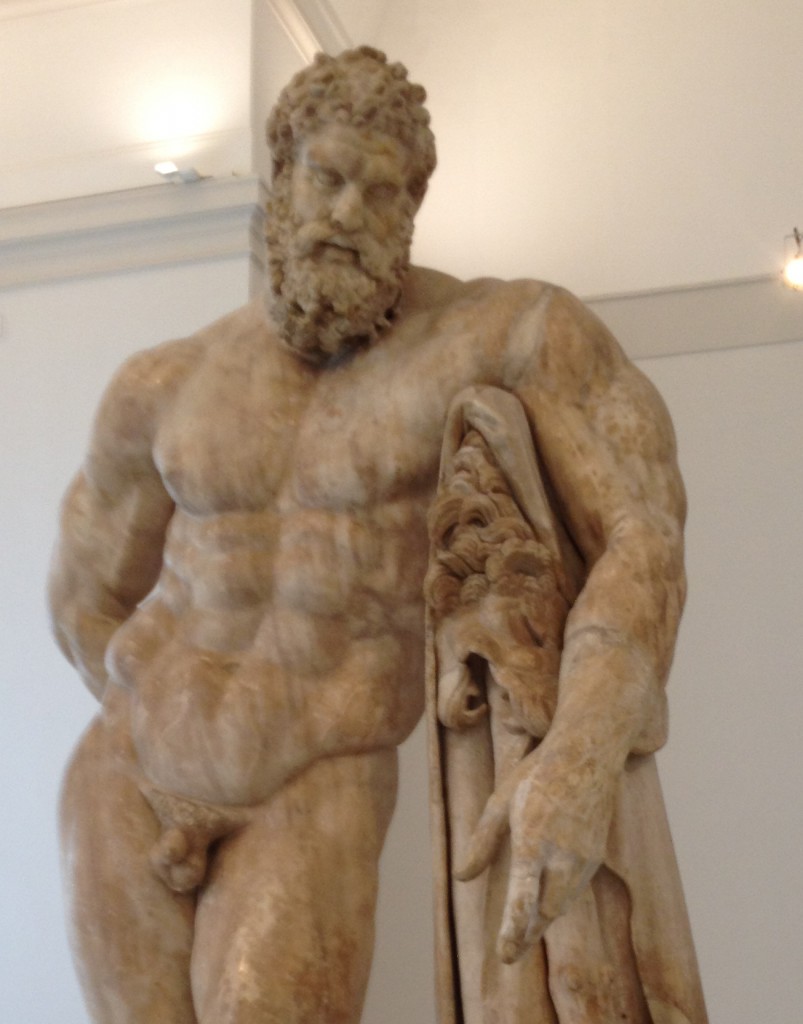 Herakles, Euripides [html | PDF]
Herakles, Euripides [html | PDF]
Translated by R. Potter, adapted by M. Ebbott & C. Dué.
Published under a Creative Commons License 3.0.
Translation augmented with H24H Core Vocab terms.
A Sampling of Comments on Euripides’ Herakles
by Gregory Nagy is now available at Classical Inquiries 2018.04.20
In H24H Professor Nagy points out that “Hēraklēs means ‘he who has the kleos of Hērā’” so he has kleos built into his name. That is, there is ‘glory, fame (especially as conferred by poetry or song); that which is heard’ (Core Vocab) and he is established as a model hero, one about whom songs would be sung.
Hērā was jealous because Zeus had fathered Herakles of Alkmene so arranged for Eurystheus to be born first and become king according to the oath Zeus had sworn (blaming Atē). Eurystheus sets Herakles a series of tasks.
In this drama, Euripides presents the aftermath of the task in which: “Hēraklēs descends to Hādēs and brings up Cerberus the Hound of Hādēs from the zone of darkness to the zone of light and life.” (H24H 1§43) Meanwhile his wife, Megara, and their three sons are under threat by Lykos, ruler of Thebes, and are taking refuge at the altar of Zeus.
Image: Detail from Farnese Heracles, via Wikimedia Commons.
Related
- Online Open House | Gregory Nagy, on Herakles, and The Best of the Achaeans
- Reading Greek Tragedy Online: Euripides Herakles video
Euripides Medea
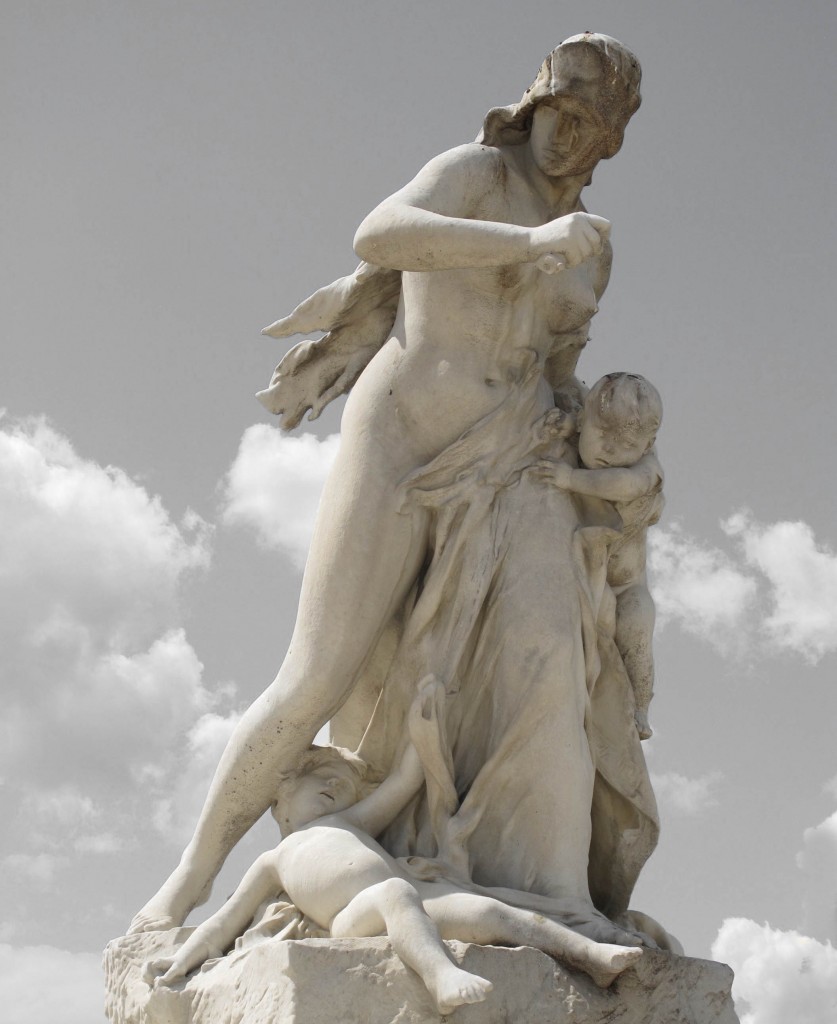 Medea, Euripides [html | PDF]
Medea, Euripides [html | PDF]
Translated by E.P. Coleridge. Revised by Roger Ceragioli. Further revised by Gregory Nagy. Now newly revised by members of Kosmos Society (then Hour 25.)
Published under a Creative Commons License 3.0.
Translation augmented with H24H Core Vocab terms.
When Jason came to Colchis in search of the Golden Fleece, he succeeded with the aid of Medea, who accompanied him back to Corinth. As the play opens she is experiencing grief and fury at his betrayal of her as he prepares to marry the ruler’s daughter. Far from her native land, and threatened with exile, Medea seeks revenge on Jason’s bride, on the bride’s father, and finally on Jason himself. By contrast when she seeks help from Aegeus he promises a place of safety in return for her help.
Euripides presents this part of the myth as more than a portrait of a woman scorned: her terrible acts of vengeance are also shown as consequences of the acts of those around her who break sacred oaths and act with hubris.
Image: By François TR, [CC BY-SA 3.0], via Wikimedia Commons.
Related
- Online Open House video: Heroine cult and tragedy, with special reference to the Medea of Euripides, with Richard P. Martin
- Reading Greek Tragedy Online: Euripides Medea video
Euripides Trojan Women
 Trojan Women, Euripides [html | PDF]
Trojan Women, Euripides [html | PDF]
Translated by E.P. Coleridge, revised by members of Kosmos Society
Published under a Creative Commons License 3.0.
Translation augmented with H24H Core Vocab terms.
Handout: Introduction to the Trojan Women (PDF) by Jack Vaughan
The Trojan Women portrays the sad lot of the surviving women and children of Troy after the taking of their beloved city by the Greeks. The Chorus represents and speaks for the Trojan women as a group. The drama presents through the sequence of scenes, as dramatic centerpieces, individual Trojan noblewomen: devastated widowed queen and mother Hecuba, raving grief-stricken assault-victim Kassandra, widowed mother Andromache, hapless young Polyxena—whose fate, being sacrificed at the tomb of Achilles, fulfilled offstage, is presented through reports, to the audience in Poseidon’s opening monologue, to the women onstage later by Talthybios—and Paris’ (Alexandros’) widow, Spartan runaway Helen, held captive along with the Trojan women. All of the individually presented women, and the child whose fate is decided by the Greeks in the action portrayed in the drama (Hector’s and Andromache’s hapless son Astyanax), are associated with the royal family. The women who appear onstage through actors—Hecuba, Kassandra, Andromache, and Helen—each have different viable claims to being much greater figures of Ancient Greek Myth and World Literature than the great nameless crowd, here represented by the Chorus, of captive Trojan women facing concubinage or enslavement in Greece. As in Homer and other poets before Euripides, Helen has a dual Greco-Trojan identity. Before leaving Sparta with Paris to be his wife in Troy, Helen was a female Ancient Greek hero in her own right. Hecuba, Kassandra, and Andromache are noble women forced to endure extreme injustice and inhumanity. Their different responses to the situations unfolding in the tragedy elicit audience sympathy and pity appropriately accorded to tragic heroines. Helen, universally blamed as the cause of the ten-years war, faces threats of a similarly ruinous fate, but—after tense confrontation by Menelaos and a three-way debate joined by Hecuba with the Chorus chiming in on her side, advancing that Menelaos punish and kill the faithless traitor woman—the Menelaos-Helen Episode ends with Menelaos and Helen leaving the stage to sail back to Greece together. The native Trojan, Phrygian, or Anatolian women who survive the Greek invasion, occupation, and killings, face at the end of the drama transport to Greece, bereft of city, home, family, and hopes of freedom and happy lives.
(overview by Jack Vaughan)
Image: Group of Statues of Mourning Women (4), 300–275 BCE, Terracotta, 85.AD.76, The J. Paul Getty Museum, Villa Collection, Malibu, California Open Content Program
Related
- Reading Greek Tragedy Online: Euripides Trojan Women video
Euripides Bacchae
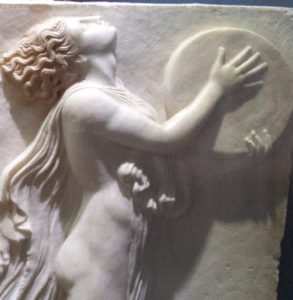 Euripides, Bacchae [html | PDF]
Euripides, Bacchae [html | PDF]
Translated by T. A. Buckley. Revised by Alex Sens. Further revised by Gregory Nagy. Published under a Creative Commons License 3.0.
Translation augmented with H24H Core Vocab terms.
Included in Sourcebook
Dionysus, or Bacchus, has arrived in Thebes with his followers, the Bacchae, in order to reveal his divinity. The Thebans had not believed his mother Semele had borne a child to Zeus so Dionysus has arisen a bacchic frenzy in the local women, but the king, Pentheus, is mistrustful of what is going on, and, encouraged by Dionysus, decides to spy on the rituals in disguise. A messenger reports the fatal reaction of the frenzied women, including Pentheus’ own mother.
Image credit: Detail from Bacchic procession, Roman, 100 CE
Photo: Szilas. Public domain, via Wikimedia Commons
Related
- Reading Greek Tragedy Online: Euripides Bacchae video
Euripides Hippolytus
Euripides, Hippolytus [html | PDF]
Translated by E. P. Coleridge. Revised by Mary Jane Rein. Further revised by Gregory Nagy.
Published under a Creative Commons License 3.0.
Translation augmented with H24H Core Vocab terms.
Included in Sourcebook
Hippolytus is to be caught between rival goddesses. By dedicating himself to Artemis, he incurs the anger of Aphrodite, who uses Hippolytus’ step-mother Phaedra as her agent of destruction.
Phaedra is made to fall passionately —and inappropriately—in love with Hippolytus, and when he rejects her, she exacts vengeance on him by claiming that he tried to seduce her. Exiled by his father Theseus, Hippolytus meets a tragic end.
Both step-mother and step-son are doomed in life, but are destined to be remembered in death, and in the establishment of associated rituals.
Image: Jean-Baptiste Lemoyne La mort d’Hippolyte 1715. Louvre
Photo: Marie-Lan Nguyen. Public domain, via Wikimedia Commons
Related
- Reading Greek Tragedy Online: Euripides Hippolytus video
SOPHOCLES
Sophocles Antigone
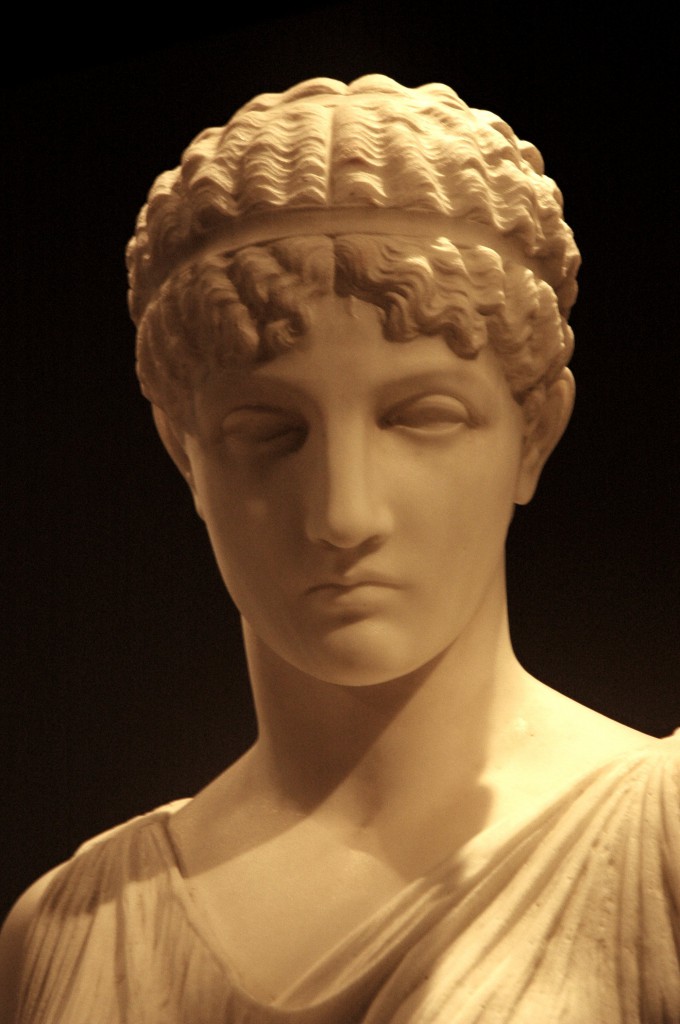 Antigone, Sophocles [html | PDF]
Antigone, Sophocles [html | PDF]
Translated by Richard Jebb, revised by Pierre Habel, further revised by Gregory Nagy. Now, newly revised by members of Kosmos Society (then Hour 25).
Published under a Creative Commons License 3.0.
Translation augmented with H24H Core Vocab terms.
For ancient Greeks engaging with such a living mytho-poetic system, Antigone would need no introduction. First-time modern readers, however, may at find it helpful to know just the basic facts about Sophocles’ use of this myth before beginning. In this tragedy, Antigone is the daughter of Oedipus the former king of Thebes who brought about his own destruction by unknowingly killing his father and marrying his mother Jocasta. After Oedipus’ self-blinding, exile, and death, his two sons (and Antigone’s two brothers), Eteokles and Polyneikes, end up quarreling for control over Thebes. War ensues when Polyneikes and six other heroes attack the seven gates of the city (the mythical “Seven Against Thebes”). In a final military confrontation, the brothers kill each other. Antigone’s uncle Creon takes control of the city and decrees that Eteokles should be given the funeral of a hero, while Polyneikes must be left unmourned and unburied. Anyone who defies this edict faces death. This is where the tragedy begins. (overview by Antigone Team)
Image: By Wonderlane (Flickr) [CC BY 2.0 (https://creativecommons.org/licenses/by/2.0)], via Wikimedia Commons
Related
- Reading Greek Tragedy Online: Sophocles Antigone video (English)
- Reading Greek Tragedy Online: Sophocles Antigone video (Modern Greek and English)
Student performances:
- Antigone Lines 1–161 | Gloucester High School, Massachusetts, USA
- Antigone Lines 155–331 | 1st and 2nd High Schools of Nafplio, Greece
- Antigone Lines 441–581 | Greek and US student performances and dialogue
- Antigone Lines 441–582 | Lynn English High School, Massachusetts, USA
- Antigone Lines 577–800 | Modern High School for Girls, Kolkata, India
- Antigone Lines 801–943 | Trinitas Gymnasium, Almere, Netherlands
- Antigone Lines 997–1114 | Ukraine
Student performances | “Ode to Mankind”: Lines 224–383
- 1st and 2nd High Schools of Nafplio, Greece
- Gloucester High School, Massachusetts, USA
- Lynn English High School, Massachusetts, USA
- Trinitas Gymnasium, Almere, Netherlands
Sophocles Oedipus at Colonus
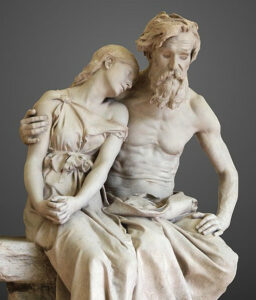 Oedipus at Colonus, Sophocles [html | PDF]
Oedipus at Colonus, Sophocles [html | PDF]
Translated by R. C. Jebb, Revised by Roger Ceragioli, Further Revised by Gregory Nagy
Published under a Creative Commons License 3.0.
Translation augmented with H24H Core Vocab terms.
Included in Sourcebook
Oedipus is presented as a blind old man in a life of wandering, led by his daughter Antigone, when he arrives at a sacred place some distance from the city of Athens—Colonus [Kolōnos]. The region is controlled by Athens, and its leader Theseus promises help to Oedipus.
But he and his family come under threat when Creon and Polyneikes, each representing opposing factions in Thebes, wish Oedipus to return to lend support to their cause.
Ultimately, with the help of Theseus, Oedipus is able to meet his mystical, wondrous end in this sacred landscape.
Image: Jean-Baptiste Hugues: Oedipus at Colonus, 1882.
Photo: Rama. Creative Commons Attribution-ShareAlike 3.0 France license, via Wikimedia Commons
Related
- Reading Greek Tragedy Online: Sophocles Oedipus at Colonus video
Sophocles Oedipus Tyrannus
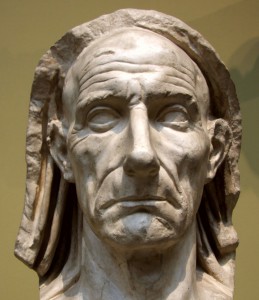 Sophocles, Oedipus Tyrannus [html | PDF]
Sophocles, Oedipus Tyrannus [html | PDF]
Translated by R. C. Jebb. Revised by Alex Sens. Further revised by Gregory Nagy.
Published under a Creative Commons License 3.0.
Translation augmented with H24H Core Vocab terms.
Included in Sourcebook
Thebes is gripped by plague, and the priests come to Oedipus for help. He has previously saved the city from the terrors of the Sphinx and is now their ruler.
Confident of his ability to help he uses the resources available to him to root out the cause and re-purify the city. But the truth is gradually revealed and his eyes are opened to how nobody can escape their fate.
Aristotle in the Poetics regarded this tragedy as exemplary drama, and it has continued to be regarded as a great play.
Image: Head of an old man in a coverlet. Marble. Mid-1st century BCE Rome, Vatican Museums, Wikimedia Commons
Note: During 2022–2023 a Kosmos Society Study group is meeting to translate and discuss Oedipus Tyrannus.
Related
- Reading Greek Tragedy Online: Sophocles Oedipus Tyrannus video (Sourcebook translation)
- Reading Greek Tragedy Online: Sophocles Oedipus Tyrannus video (translation by Oliver Taplin)
Philosophy and other texts
Overview
Plato
 Plato, The Apology of Socrates [html | PDF]
Plato, The Apology of Socrates [html | PDF]
Translated by Benjamin Jowett. Adapted by Miriam Carlisle, Thomas E. Jenkins, Gregory Nagy, and Soo-Young Kim.
Published under a Creative Commons License 3.0.
Included in Sourcebook
Plato, Phaedo [html | PDF]
Translated by Benjamin Jowett. Adapted by Gregory Nagy, Miriam Carlisle, and Soo-Young Kim.
Published under a Creative Commons License 3.0.
Translation augmented with H24H Core Vocab terms.
Included in Sourcebook
Note: During 2022–2023 a Kosmos Society study group is meeting to translate and discuss the Phaedo.
Image: Portrait of Socrates. Marble, Roman artwork (1st century), perhaps a copy of a lost bronze statue made by Lysippos. Louvre.
Photo: Sting, Creative Commons Attribution-Share Alike 2.5 Generic license, via Wikimedia Commons
Plato, Further Selections [html | PDF]
Translated by Gregory Nagy
Published under a Creative Commons License 3.0.
Translation augmented with H24H Core Vocab terms.
Included in Sourcebook
Aristotle
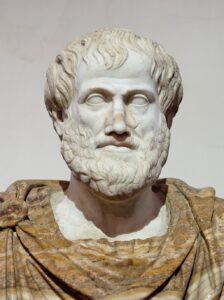 Selections from Aristotle [html | PDF]
Selections from Aristotle [html | PDF]
Translated by Lynn Sawlich, revised by Gregory Nagy
Translation augmented with H24H Core Vocab terms.
Included in Sourcebook
These selections are from Poetics (Mimesis, Catharsis, Poetry & History, Subject Matter), Politics (Catharsis) and Rhetoric (Mimesis).
Image credit: Bust of Aristotle. Marble, Roman copy after a Greek bronze original by Lysippos from 330 BCE; the alabaster mantle is a modern addition.
Photo: Jastrow. Public domain via Wikimedia Commons
Additional Selections
Additional Selections from Ancient Greek and Other Texts [html | PDF]
Translated by Gregory Nagy
Translation augmented with H24H Core Vocab terms.
Included in Sourcebook
These selections include short passages from: Bacchylides, ‘pseudo’-Demosthenes, Dio of Prusa, Euripides Herakles, Heraclitus, Homeric Hymn to Herakles, Keilschrifturkunden aus Boghazköi, Scholia for Lycophron, Matthew, Plutarch, Franz von Schober, Giorgos Seferis, Theophrastus
The Ancient Greek Hero in 24 Hours Sourcebook
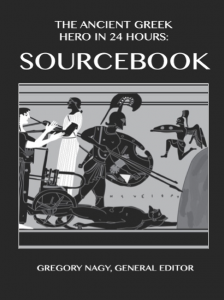 Sourcebook of Original Greek Texts Translated into English
Sourcebook of Original Greek Texts Translated into English
v15: December 2020
[ epub]
[ PDF ]
[ Kindle-compatible mobi file ]
(add the .mobi extension when you have downloaded it)
General Editor, Gregory Nagy
The Sourcebook of Original Greek Texts Translated into English contains accessible and enhanced translations of all the primary texts discussed in Nagy’s The Ancient Greek Hero in 24 Hours, making it the perfect companion volume for those working through H24H or other HeroesX content. Yet the Sourcebook also stands on its own as a unique, open-source publication. Edited with the help of Nagy’s fellow teachers and researchers, these translations are enhanced with transliterated Greek tags that to allow readers to track the use of key terms and concepts.
Here’s how Nagy describes the Sourcebook in H24H. “The process of editing this Sourcebook is an ongoing project that I hope will outlast my own lifetime. All the translations in this online Sourcebook are free from copyright restrictions. That is because the translations belong either to me or to other authors who have waived copyright or to authors who died in a time that precedes any further application of copyright. The texts of these translations in the Sourcebook are periodically reviewed and modified, and the modifications are indicated by way of special formatting designed to show the differences between the original translator’s version and the modified version.”
The texts provided include: the Homeric Iliad and Odyssey; Hesiod’s Theogony and Works and Days, Homeric Hymns, a selection of lyric poetry by Alcman, Sappho, and Pindar; Agamemnon, Libation Bearers, and the Eumenides by Aeschylus; Oedipus at Colonus and Oedipus Tyrannus by Sophocles; the Hippolytus and Bacchae of Euripides; selections from Aristotle, Herodotus, and Pausanius; and Plato’s Apology and Phaedo.
Other publications
Browse all publications from the Center for Hellenic Studies

